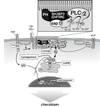The role of SH3BP2 in the pathophysiology of cherubism
- PMID: 22640988
- PMCID: PMC3359958
- DOI: 10.1186/1750-1172-7-S1-S5
The role of SH3BP2 in the pathophysiology of cherubism
Abstract
Cherubism is a rare bone dysplasia that is characterized by symmetrical bone resorption limited to the jaws. Bone lesions are filled with soft fibrous giant cell-rich tissue that can expand and cause severe facial deformity. The disorder typically begins in children at ages of 2-5 years and the bone resorption and facial swelling continues until puberty; in most cases the lesions regress spontaneously thereafter. Most patients with cherubism have germline mutations in the gene encoding SH3BP2, an adapter protein involved in adaptive and innate immune response signaling. A mouse model carrying a Pro416Arg mutation in SH3BP2 develops osteopenia and expansile lytic lesions in bone and some soft tissue organs. In this review we discuss the genetics of cherubism, the biological functions of SH3BP2 and the analysis of the mouse model. The data suggest that the underlying cause for cherubism is a systemic autoinflammatory response to physiologic challenges despite the localized appearance of bone resorption and fibrous expansion to the jaws in humans.
Figures



References
-
- Jones WA. Familial multilocular cystic disease of the jaws. American Journal of Cancer. 1933;17:946–950.
-
- Jones WA, Gerrie J, Pritchard J. Cherubism--familial fibrous dysplasia of the jaws. J Bone Joint Surg Br. 1950;32-B:334–347. - PubMed
-
- Anderson DE, McClendon JL. Cherubism - hereditary fibrous dysplasia of the jaws. I. Genetic considerations. Oral Surgery Oral Medicine Oral Pathology. 1962;15:5–16.
Publication types
MeSH terms
Substances
Grants and funding
LinkOut - more resources
Full Text Sources
Medical

